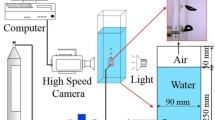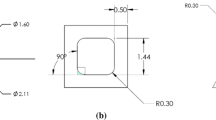Abstract
The aim of this study was to investigate bubble/drop formation at a single submerged orifice in stagnant Newtonian fluids and to gain qualitative understanding of the formation mechanism. The effects of various governing parameters were studied. Formation behavior of bubbles and drops in Newtonian aqueous solutions were investigated experimentally under different operating conditions with various orifices. The results show that the volume of the detached dispersed phase (bubble or drop) increases with the viscosity of the continuous phase (or dispersion medium), surface tension, orifice diameter, and dispersed phase flow rate. A PIV system was employed to measure the velocity flow field quantitatively during the bubble/drop formation, giving interesting information useful for the elucidation of the fundamental formation process at the orifice. It was revealed that the orifice shape strongly influences the size of the bubble formed. Furthermore, based on a simple mass balance, a general correlation successfully predicting both bubble and drop sizes has been proposed.
Similar content being viewed by others
References
Badam, V. K., Buwa, V., & Durst, F. (2007). Experimental investigations of regimes of bubble formation on submerged orifices under constant flow condition. Canadian Journal of Chemical Engineering, 85, 257–267. DOI: 10.1002/cjce.5450850301.
Bashforth, F., & Adams, J. C. (1883). An attempt to test the theories of capillary action by comparing the theoretical and measured forms of drops of fluid with an explanation of the method of integration employed in constructing the tables which give the theoretical forms of such drops. Cambridge, UK: Cambridge University Press.
Chang, B., Nave, G., & Jung, S. H. (2012). Drop formation from a wettable nozzle. Communications in Nonlinear Science and Numerical Simulation, 17, 2045–2051. DOI: 10.1016/j.cnsns.2011.08.023.
Clift, R., Grace, J. R., & Weber, M. E. (1978). Bubbles, drops and particles. New York, NY, USA: Academic Press.
Davidson, J. F., & Schüler, B. O. G. (1960a). Bubble formation at an orifice in a viscous liquid. Transactions of the Institution of Chemical Engineers, 38, 144–154.
Davidson, J. F., & Schüler, B. O. G. (1960b). Bubble formation at an orifice in an inviscid liquid. Transactions of the Institution of Chemical Engineers, 38, 335–342.
de Chazal, L. E. M., & Ryan, J. T. (1971). Formation of organic drops in water. AIChE Journal, 17, 1226–1229. DOI: 10.1002/aic.690170531.
Dietrich, N., Poncin, S., Pheulpin, S., & Li, H. Z. (2008). Passage of a bubble through a liquid-liquid interface. AICHE Journal, 54, 594–600. DOI: 10.1002/aic.11399.
Dietrich, N., Poncin, S., & Li, H. Z. (2011). Dynamical deformation of a flat liquid-liquid interface. Experiments in Fluids, 50, 1293–1303. DOI: 10.1007/s00348-010-0989-7.
Frank, X., Funfschilling, D., Midoux, N., & Li, H. Z. (2006). Bubbles in a viscous liquid: lattice Boltzmann simulation and experimental validation. Journal of Fluid Mechanics, 546, 113–122. DOI: 10.1017/s0022112005007135.
Funfschilling, D., & Li, H. Z. (2001). Flow of non-Newtonian fluids around bubbles: PIV measurements and birefringence visualization. Chemical Engineering Science, 56, 1137–1141. DOI: 10.1016/s0009-2509(00)00332-8.
Gaddis, E., & Vogelpohl, A. (1986). Bubble formation in quiescent liquids under constant flow conditions. Chemical Engineering Science, 41, 97–105. DOI: 10.1016/0009-2509(86)85202-2.
Heertjes, P. M., & de Nie, L. H. (1971). Mass transfer to drops. In C. Hanson (Ed.), Recent advances in liquid-liquid extraction (pp. 367–406). Oxford, UK: Pergamon Press.
Jamialahmadi, M., Zehtaban, M. R., Müller-Steinhagen, H. M., Sarrafi, A., & Smith, J. M. (2001). Study of bubble formation under constant flow conditions. Chemical Engineering Research and Design, 79, 523–532. DOI: 10.1205/02638760152424299.
Kulkarni, A. A., & Joshi, J. B. (2005). Bubble formation and bubble rise velocity in gas-liquid systems: A review. Industrial & Engineering Chemistry Research, 44, 5873–5931. DOI: 10.1021/ie049131p
Kumar, R., & Kuloor, N. R. (1970). The formation of bubbles and drops. Advances in Chemical Engineering, 8, 255–368. DOI: 10.1016/s0065-2377(08)60186-6.
Li, H. Z., Frank, X., Funfschilling, D., & Mouline, Y. (2001). Towards the understanding of bubble interactions and coalescence in non-Newtonian fluids: a cognitive approach. Chemical Engineering Science, 56, 6419–6425. DOI: 10.1016/s0009-2509(01)00269-x.
Li, H. Z., Mouline, Y., & Midoux, N. (2002). Modelling the bubble formation dynamics in non-Newtonian fluids. Chemical Engineering Science, 57, 339–346. DOI: 10.1016/s0009-2509(01)00394-3.
Narasinga Rao, E. V. L., Kumar, R., & Kuloor, N. R. (1966). Drop formation studies in liquid-liquid systems. Chemical Engineering Science, 21, 867–880. DOI: 10.1016/0009-2509(66)85081-9.
Marmur, A. (2004). Adhesion and wetting in an aqueous environment: Theoretical assessment of sensitivity to the solid surface energy. Langmuir, 20, 1317–1320. DOI: 10.1021/la0359124.
Michael, D. H. (1981). Meniscus stability. Annual Review of Fluid Mechanics, 13, 189–216. DOI: 10.1146/annurev.fl.13.010181.001201.
Null, H. R., & Johnson, H. F. (1958). Drop formation in liquidliquid systems from single nozzles. AIChE Journal, 4, 273–281. DOI: 10.1002/aic.690040308.
Oguz, H. N., & Prosperetti, A. (1993). Dynamics of bubble growth and detachment from a needle. Journal of Fluid Mechanics, 257, 111–145. DOI: 10.1017/s0022112093003015.
Scarano, F. (1997). Improvements in PIV image processing application to a backward facing step. Rhode-Saint-Genèse, Belgium: von Karman Institute for Fluid Dynamics. (VKI PR 1997-01)
Scheele G. F., & Meister, B. J. (1968a). Drop formation at low velocities in liquid-liquid systems: Part I. Prediction of drop volume. AIChE Journal, 14, 9–15. DOI: 10.1002/aic.690140105.
Scheele, G. F., & Meister, B. J. (1968b). Drop formation at low velocities in liquid-liquid systems: Part II: Prediction of jetting velocity. AIChE Journal, 14, 16–19. DOI: 10.1002/aic.690140106.
Tate, T. (1864). On the magnitude of a drop of liquid formed under different circumstances. London, Edinburgh, and Dublin Philosophical Magazine and Journal of Science, Series 4, 27, 176–180.
Timgren, A., Trägårdh, G., & Trägårdh, C. (2008). Application of the PIV technique to measurements around and inside a forming drop in a liquid-liquid system. Experiments in Fluids, 44, 565–575. DOI: 10.1007/s00348-007-0416-x.
Tsuge, H. (1986). Hydrodynamics of bubble formation from submerged orifices. In N. P. Cheremisinoff (Ed.), Encyclopedia of fluid mechanics (Vol. 3, pp. 191). Houston, TX, USA: Gulf.
Zhang, X. G. (1999). Dynamics of drop formation in viscous flows. Chemical Engineering Science, 54, 1759–1774. DOI: 10.1016/s0009-2509 (99)00027-5.
Author information
Authors and Affiliations
Corresponding author
Rights and permissions
About this article
Cite this article
Dietrich, N., Mayoufi, N., Poncin, S. et al. Experimental investigation of bubble and drop formation at submerged orifices. Chem. Pap. 67, 313–325 (2013). https://doi.org/10.2478/s11696-012-0277-5
Received:
Revised:
Accepted:
Published:
Issue Date:
DOI: https://doi.org/10.2478/s11696-012-0277-5




